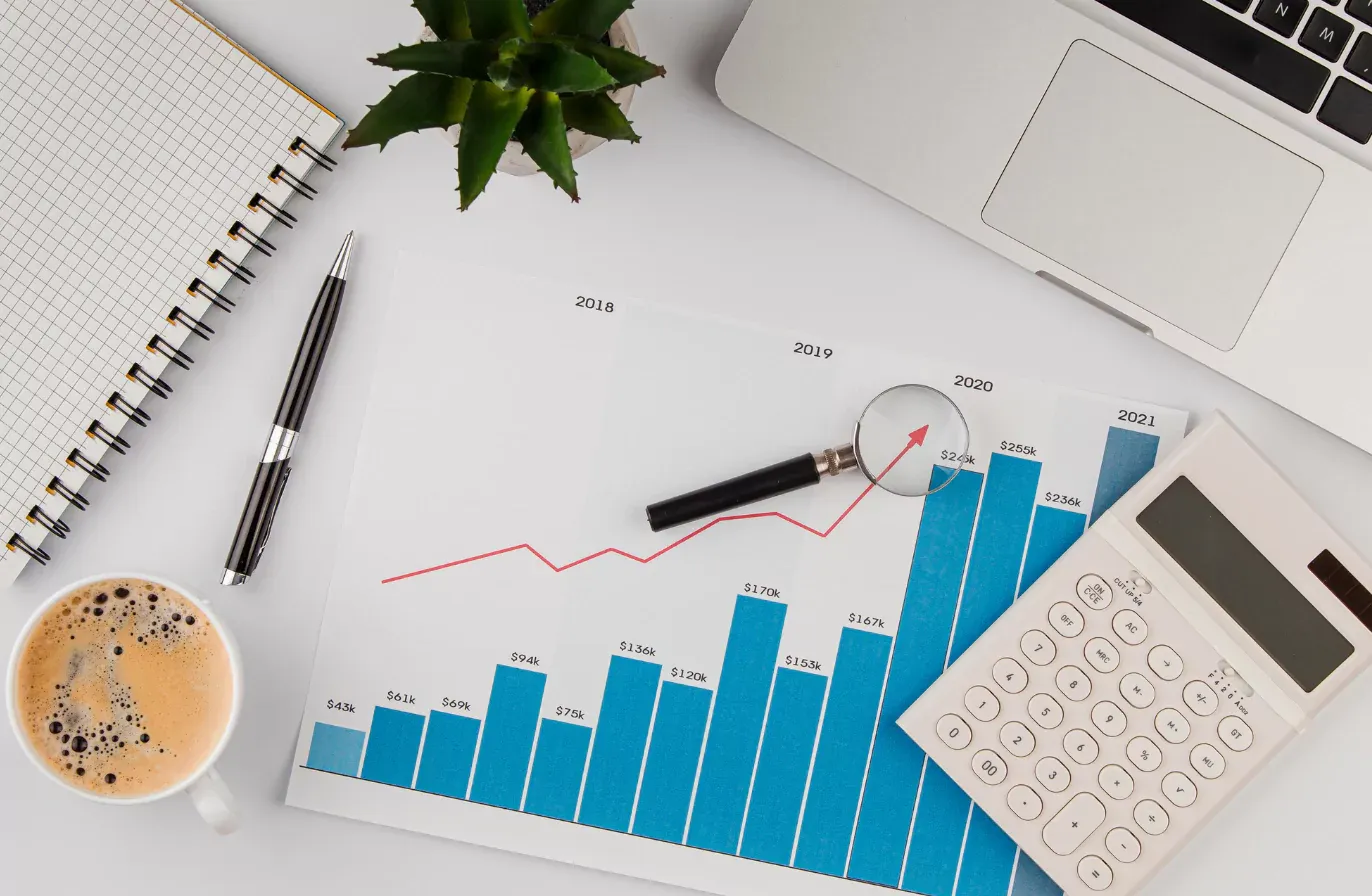LinkedIn Video Marketing: Future Trends That Will Shape the Landscape
Unlock the potential of LinkedIn video marketing with expert techniques. Discover helpful strategies for creating videos that drive action.
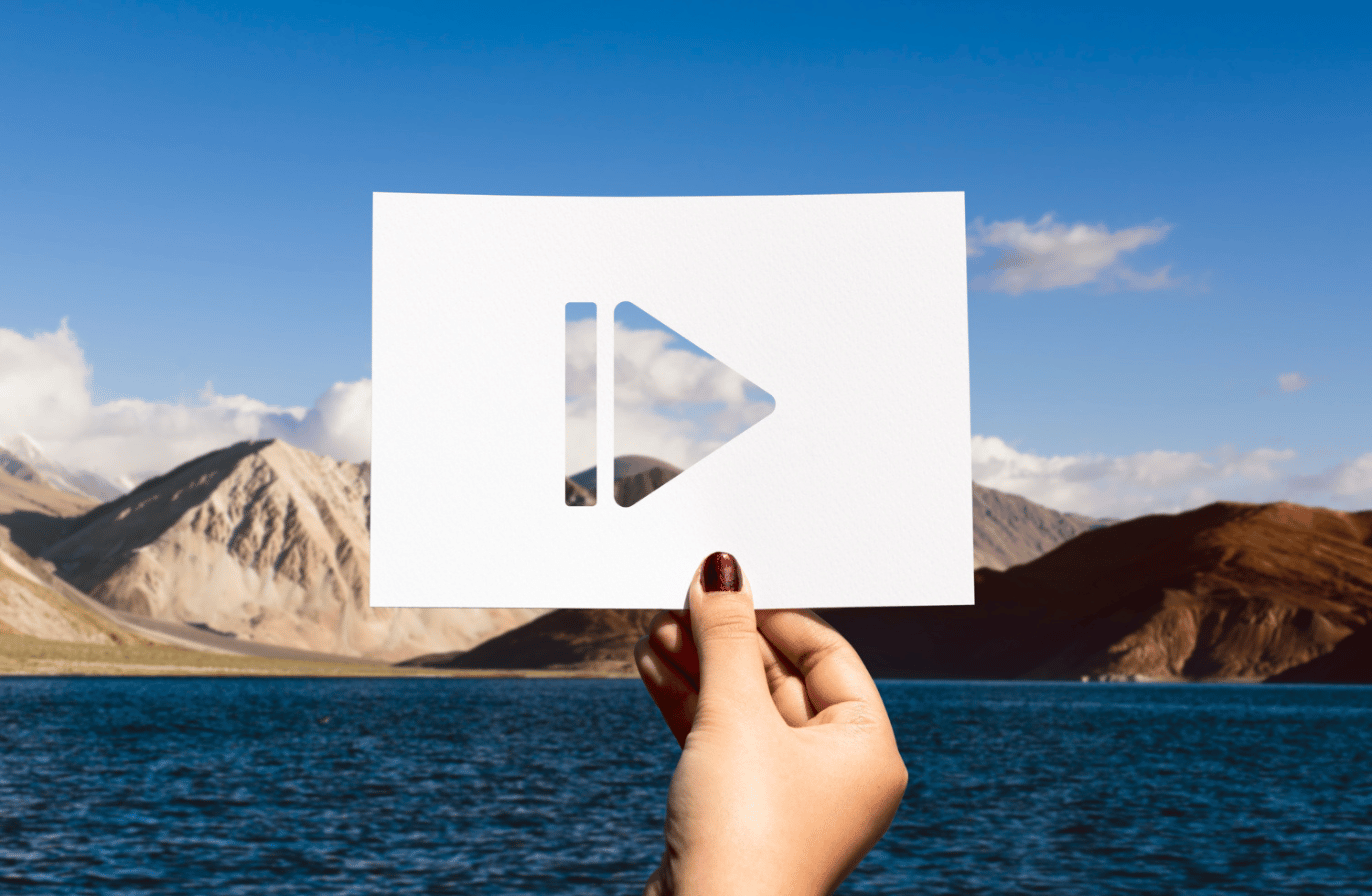
Video content is everywhere, and LinkedIn just got a memo on that. Videos on LinkedIn are now one of the top-performing content types in both organic and paid. That makes them a very considerable part of a successful LinkedIn marketing strategy.
The question is not whether video works on LinkedIn, but how to make it work for your business. This LinkedIn video marketing guide breaks down what's coming next and how to build a video marketing strategy that delivers results.
Read on for useful statistics about LinkedIn video usage and nine actionable tips for video marketing on LinkedIn!
Key takeaways
-
Videos rank in the top 3 most engaging formats on LinkedIn, with rates up to 6.70% for small accounts.
-
Real content beats fancy production: every business has something to share through worker stories and behind-the-scenes videos.
-
LinkedIn favors native video uploads over links, bringing 38% more engagement than YouTube shares.
LinkedIn video statistics
Before diving into strategy, it helps to understand just how powerful video has become on LinkedIn. Recent data highlights the role of video in driving engagement, building trust, and boosting conversions on the platform:
- 1 in 5 videos drives 80% of new subscribers within a 30-day period. This shows that not every video needs to go viral — a few strong performers can make the biggest difference in growing your audience. (source: Zebracat)
- 62% of B2B buyers trust LinkedIn video content. That makes LinkedIn one of the most reliable platforms for video marketing in the B2B space, where trust and authority are critical. (source: Vidico)
- LinkedIn video ads hold attention 3x longer than static ads. Longer watch time means your brand message has more room to resonate and stick with your audience.
- Video ads can increase conversion rates by up to 30%. Beyond engagement, videos also prove their value at the bottom of the funnel, driving real business results.
How important is video content for effective LinkedIn marketing nowadays?
LinkedIn held out longer than most, but the video revolution has finally arrived.
While platforms like TikTok and Instagram went all-in on video a while ago, LinkedIn stuck to its text-heavy roots. But with a global shift to video strategy, it’s catch-up or be forgotten. And LinkedIn chose to catch up.
Although it’s still not there quite yet, Socialinsider’s LinkedIn benchmarks study showed that videos belong in the top 3 most engaging formats on LinkedIn with an average engagement rate of 5.60%.

And here's where it gets interesting. Video performance varies significantly based on your page size.
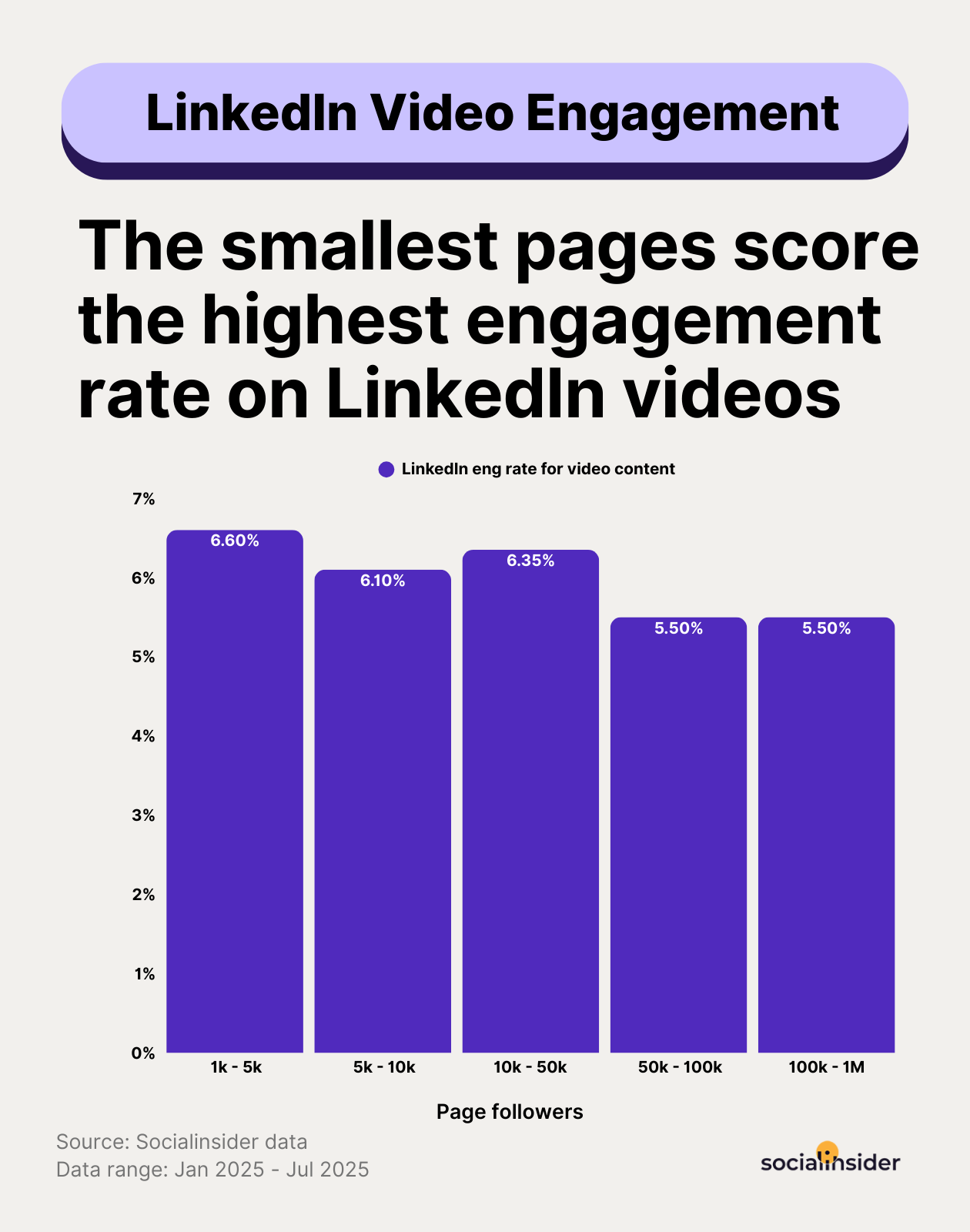
That means that if you're a smaller brand, you can gain a lot from video content.
For brands with more than 50K followers, videos are still performing strongly compared to other LinkedIn post formats, but the gap narrows as your audience grows. You could be looking at a 5.45% engagement rate, which is still solid, but not as strong as on smaller accounts.
However, in terms of views, thing look a bit different, with the largest company pages scoring significantly more views compared to smaller ones.
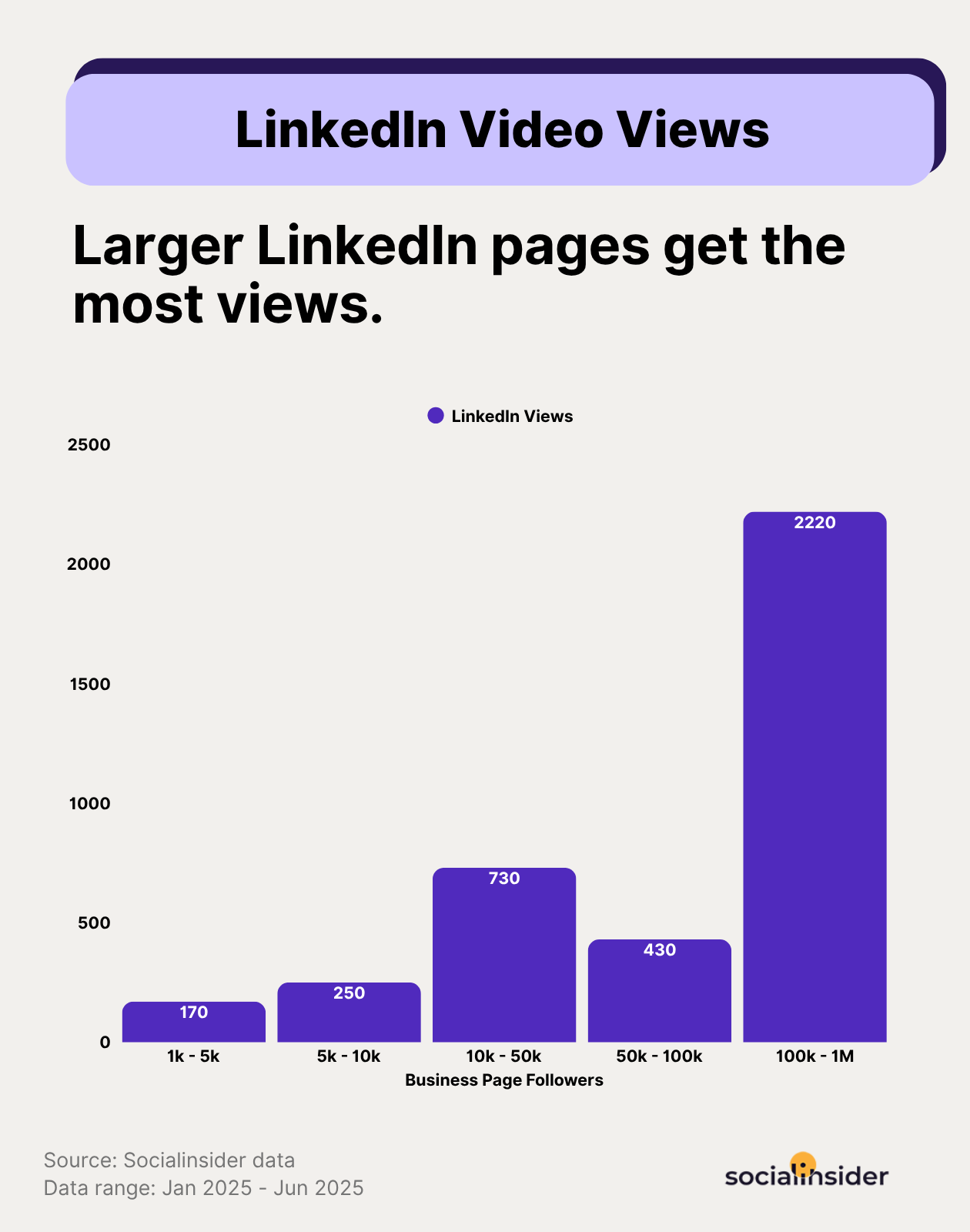
And now that I've emphasized how far video content can take your company, you may wonder what's next.
Well, I still have a few tips to give you.
For optimized engagement, I recommend choosing a length of around 2 minutes, as this video duration has proved to be the best performing, according to our latest video performance benchmarks study.
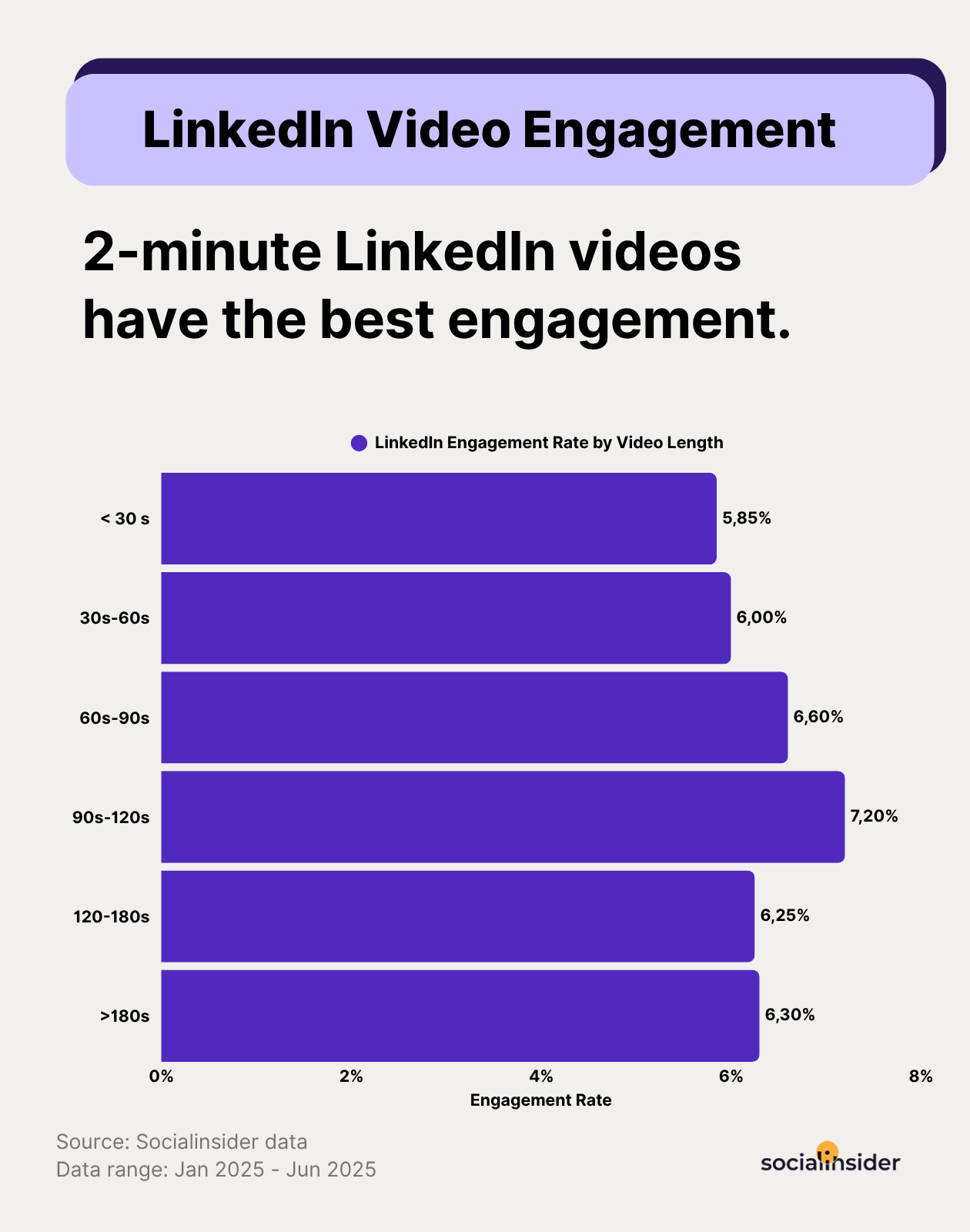
Now let's talk views. If this is the primary metric you're measuring your video performance by, then you should take into consideration that for this particular goal, 3-minute videos perform best.
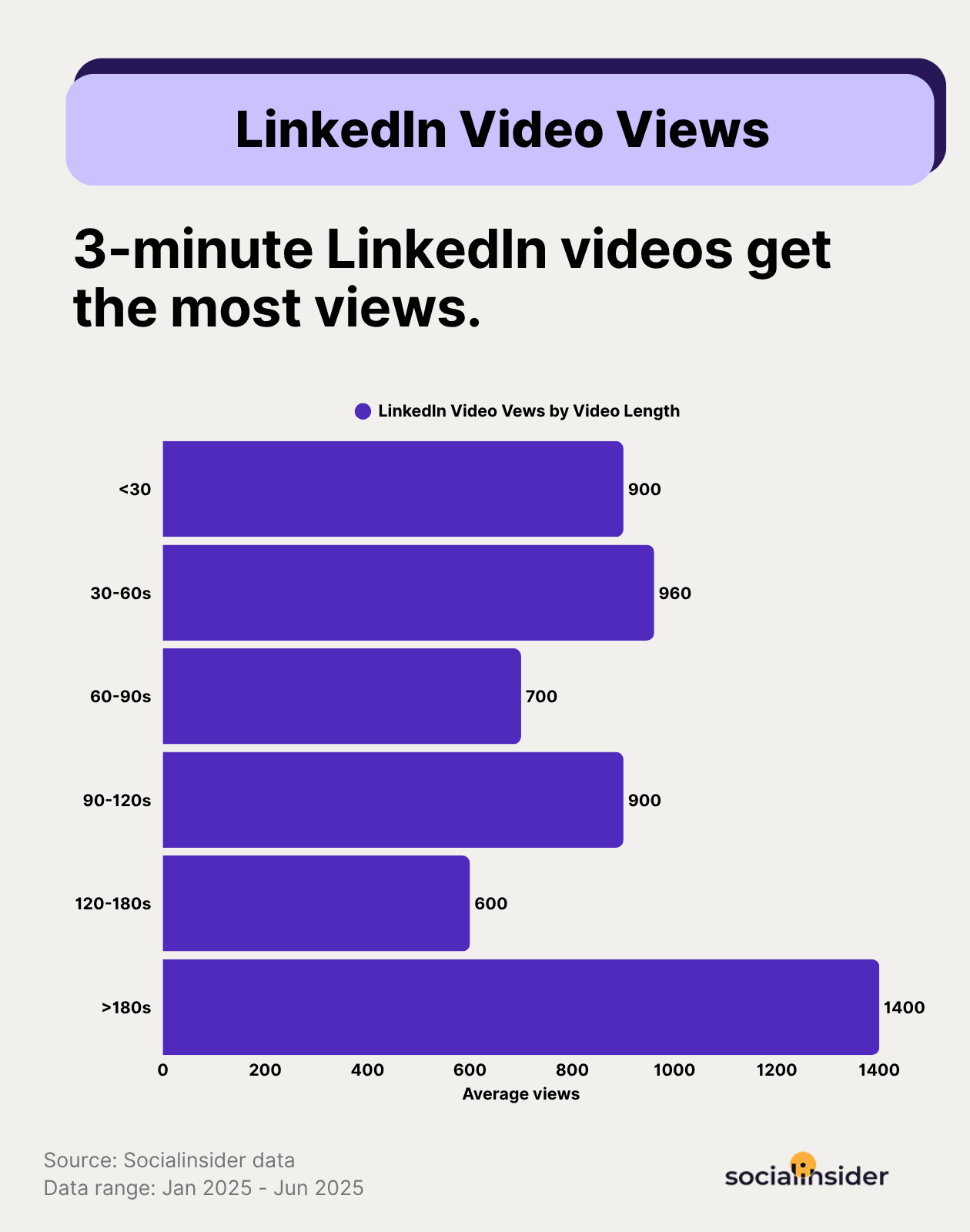
Unlike other social platforms where attention spans are shorter, LinkedIn users are generally in a professional mindset and open to learning. That’s why slightly longer videos, around 2–3 minutes, tend to perform better here, with people being willing to spend more time if the content feels useful and relevant to their work.
What's driving the shift toward video-first content strategies?
Brands are doubling down on LinkedIn video marketing. In the same benchmarks study, we discovered that brands have increased their usage of video content by 8% year-over-year
But why the sudden rush to video formats for LinkedIn?
LinkedIn algorithm favors native video
LinkedIn's algorithm is favoring video content extremely highly now, as a shift to catch up with other platforms.
It prioritizes native content that keeps users on the platform, and native video outperforms external links. Uploading a video directly to LinkedIn brings 38% more engagement than sharing a link to YouTube.
LinkedIn doesn't want users leaving the site, and what could work better than binge-watching?
Trust and authenticity demand
B2B buyers increasingly want to see the humans behind brands. The audience is pretty done with the cold-blooded sales pitch and wants to connect with real human beings instead of PR polished comms.
Video allows for this connection in ways that text can't really match. 62% of B2B buyers trust LinkedIn video content, and that trust translates to business results.
When potential clients can see your expertise and hear your voice, it builds credibility that static posts can’t quite hit.
Emphasizing this tendency, in a webinar hosted together with Adina Jipa, Socialinsider's CMO, Louise Brogan, LinkedIn video marketing expert said:
Video content humanizes a brand — because there’s an actual person behind the screen.
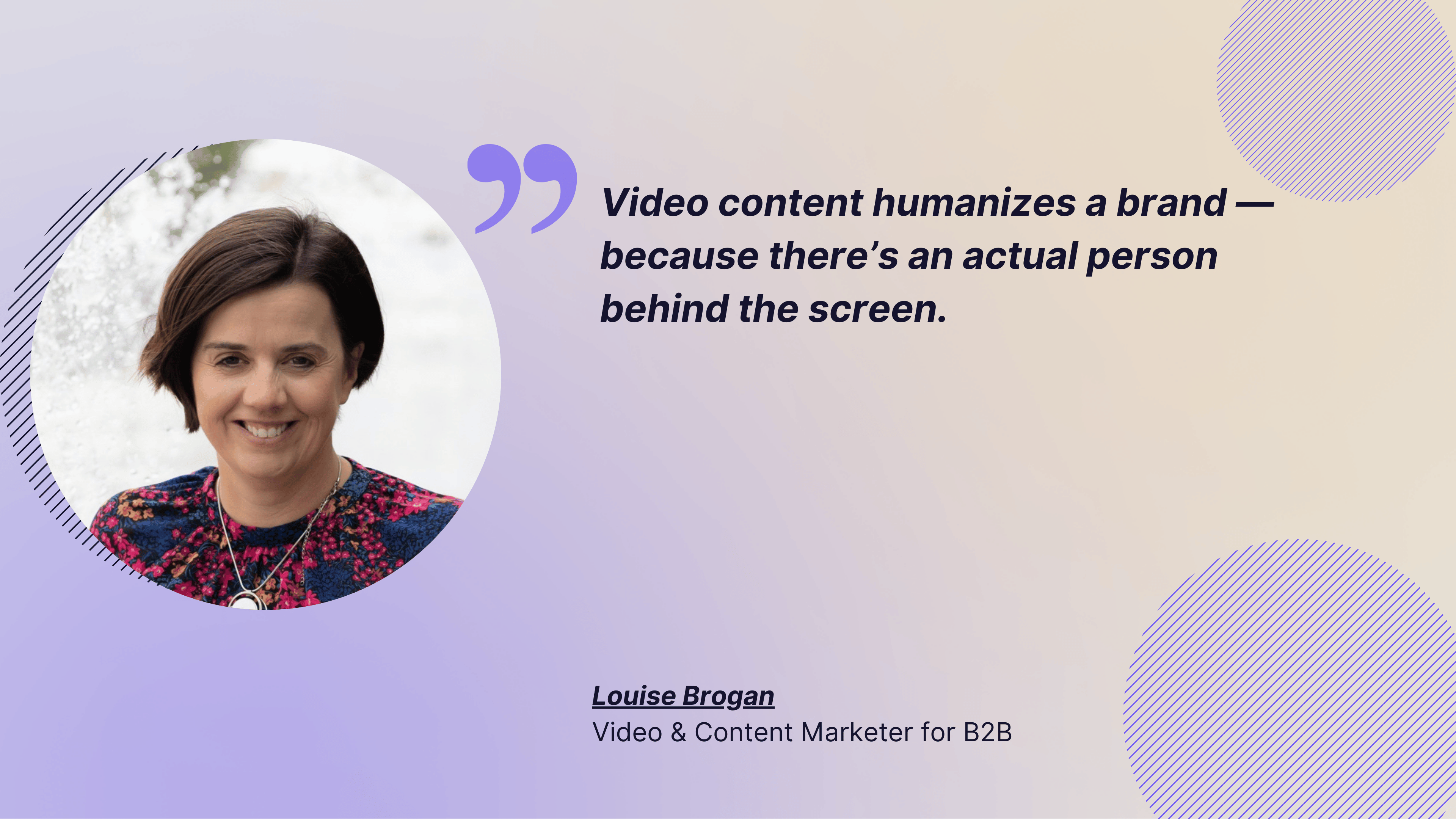
LinkedIn video trends that will shape your marketing strategy
Video is the king of content right now. But frankly, it's also the format that gives most marketers the biggest headaches. Sometimes it’s hard enough to think of what to post on LinkedIn, let alone how to make videos a part of it.
Here are the nine LinkedIn video trends you can use as sustainable ways to create quality video content.
#1. Employee-generated content
One-person content teams are becoming a thing of the past. Brands are turning their employees into content creators, and I’ve got to say — this social media tactic works.
Employee-generated content feels authentic. It helps you create more content and reaches new networks. Advocacy is what makes content boats float, and I’m very much into this.
Your sales rep's LinkedIn post about closing a difficult deal will always feel more genuine than a polished company announcement. Yes, even if you use emojis. Plus, employees have their own followers who trust their perspectives.
tl;dv has mastered this approach with three creators on their team: Renee, Ian, and Tomas. Each brings their unique voice and expertise to LinkedIn. These videos always generate tons of engagement and spread like wildfire — I’m pretty sure I first saw those on TikTok, not LinkedIn.
This type of social media content doesn’t feel overly marketing. On the contrary, it feels native to the feed, like you’re following not a company representative, but a peer.
LinkedIn video best practice:
- Find your natural storytellers. Look for employees who already use LinkedIn or have unique views to share.
- Give them creative freedom. Don't over-script their content. Real beats perfect every time.
- Provide light training. Share basic video tips and brand rules, but let their personalities show.
- Amplify strategically. Reshare their best posts on your company page to extend reach without being pushy.
#2. Influencer partnerships
LinkedIn influencer marketing has moved way beyond sponsored posts and awkward product placements.
Brands are collaborating with industry experts not only to push products, but to showcase expertise and build credibility by sharing valuable content.
The best practices of influencer video collaborations on LinkedIn all boil down to authenticity. When respected voices appear in your video for LinkedIn, it positions your brand as a trusted resource without feeling salesy.
Here's how this works in practice: a collaboration between Socialinsider and freelance strategist Caity Barnes.
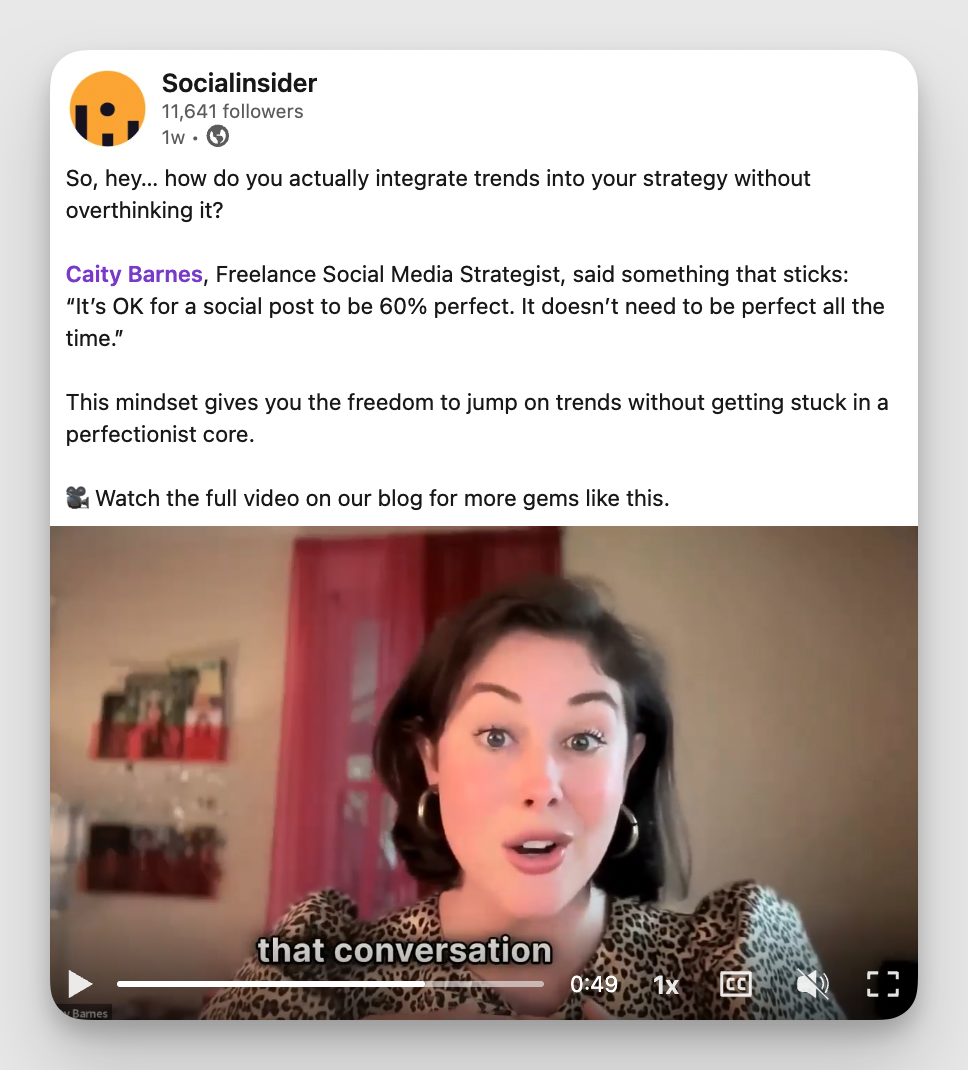
Instead of a traditional sponsored post, the team created a conversational LinkedIn video where Caity shares actionable tips about integrating trends into your strategy. The video feels natural, provides real value, and gives expert points to both parties.
LinkedIn users want professional insights that'll make them better at their jobs. The best B2B influencer marketing partnerships feel like natural conversations between industry peers, not forced promotional content.
LinkedIn video best practice:
- Target micro-influencers in your niche. They often have higher engagement rates and more authentic connections with their audience.
- Create value-first content. Think tutorials, industry insights, or other practical things your shared audience would find useful.
- Expand beyond single videos. Expert collaborations often generate enough insights for multiple video marketing ideas and content formats.
- Pay attention to metrics. Track meaningful engagement, comments, and how the partnership impacts your overall brand perception.
#3. LinkedIn Live streaming
Live streams on LinkedIn get seven times the reactions and twenty-four times the comments compared to regular videos. This makes LinkedIn Live a very useful addition to any LinkedIn content strategy.
You have two main options: host your own events or join others as a guest expert. Both work well for different goals.
Hosting your own LinkedIn Live sessions gives you full control. LinkedIn best practices are all about bringing value to your audience, so think weekly industry updates, Q&A sessions, or behind-the-scenes content.
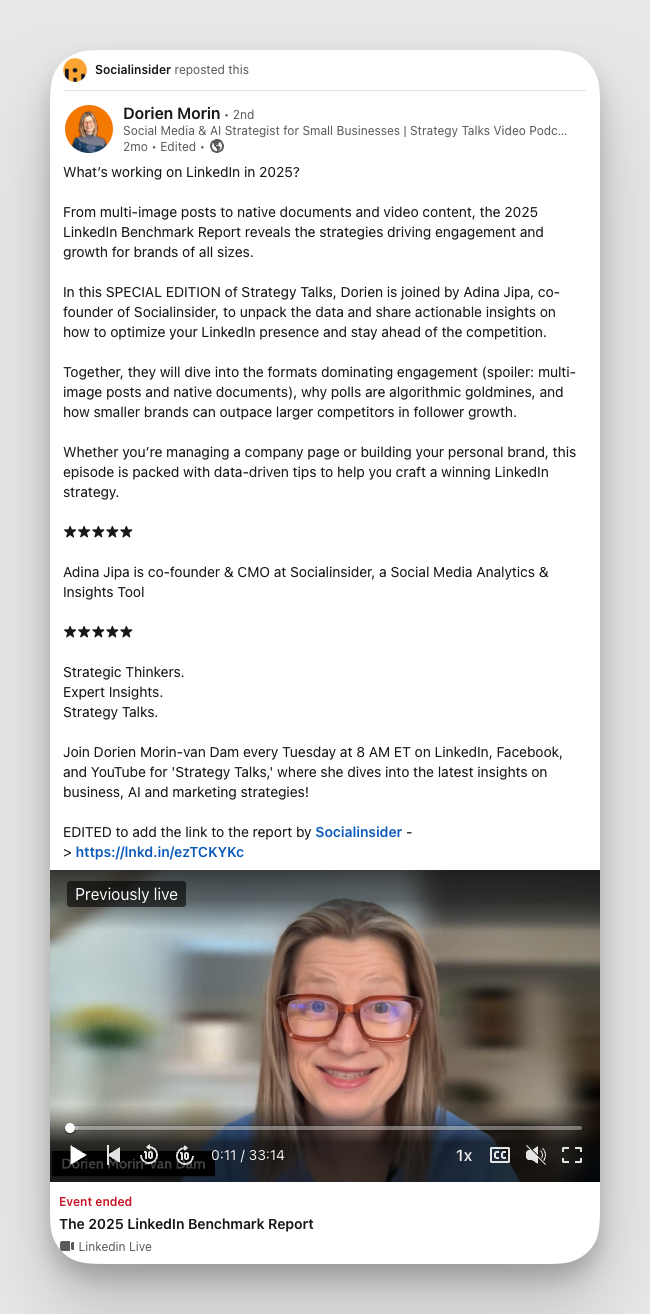
The guest route can be just as effective. Socialinsider's CEO, Adina Jipa, recently joined Dorien Morin's Strategy Talks to discuss LinkedIn benchmarks. Being a guest speaker allows you to tap into an existing community and score content worth reposting later.
Both strategies help expand your reach and credibility. You're either building your own engaged audience or tapping into someone else's established community to show your expertise.
LinkedIn video best practices:
- Start with guest appearances. It's easier than hosting and helps you understand the format.
- Plan your content series. One-off events get lost, but regular shows build anticipation.
- Repurpose ruthlessly. Turn live sessions into video clips, quote graphics, and blog posts.
- Promote in advance. Let people know you’ll be speaking before going live.
#4. Repurposing content from webinars, IRL events, and podcasts
You might've noticed I mentioned repurposing a lot, and there's a good reason for that. When you care about your social media ROI, you want to make the most out of every piece.
The sheer beauty of repurposing lies in reaching different audiences across multiple media. Your hour-long webinar can become five LinkedIn videos, ten quote graphics, and three blog posts. Very frugal.
Here's Louise's take on that
One video can fuel your whole content calendar — you can turn it into clips, carousels, text posts, even newsletters and articles.

Here’s how Socialinsider does it, turning a live Strategy Talks session into a short LinkedIn video clip.
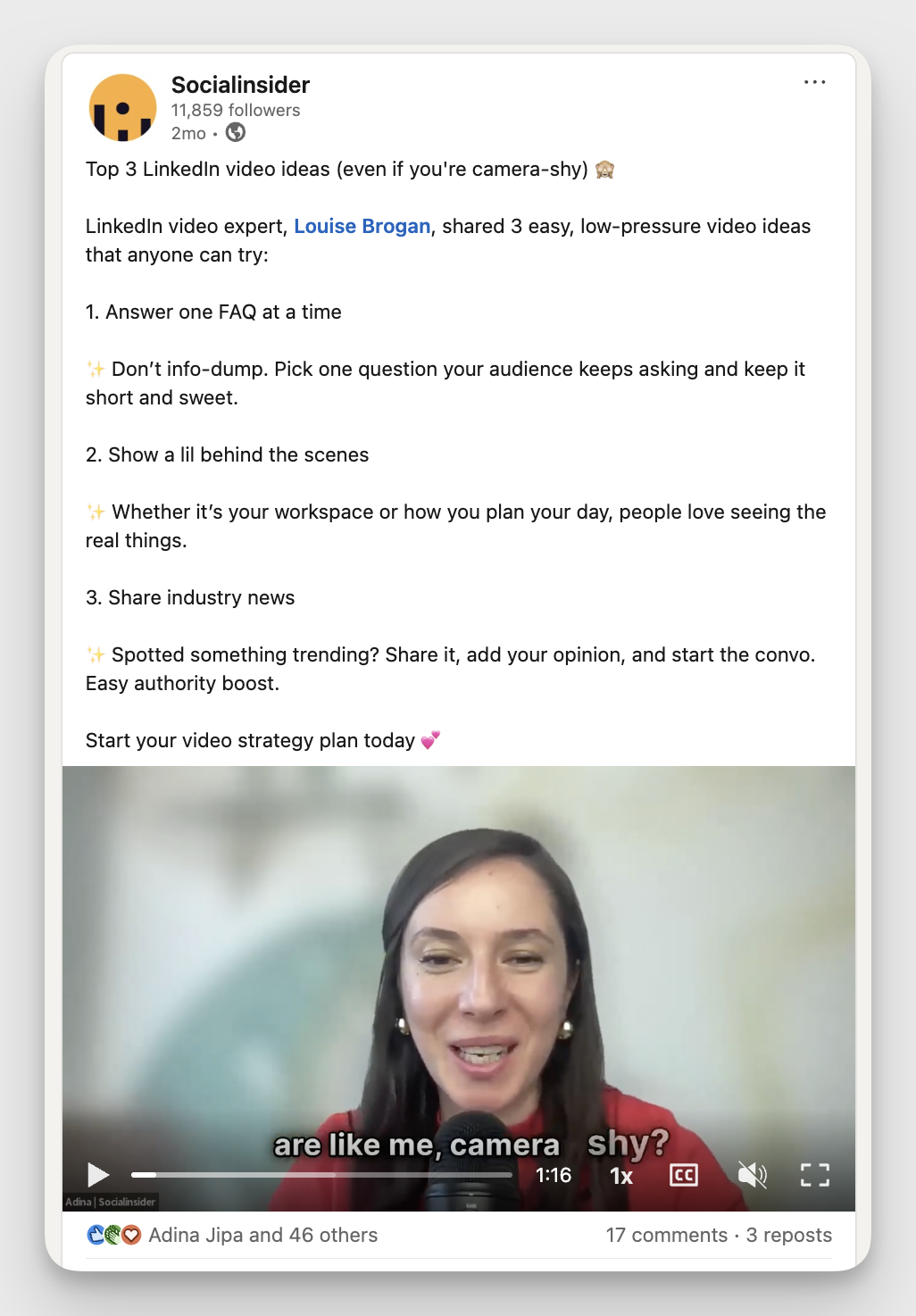
Instead of letting a valuable discussion rest in peace on the website, the team extracted the most actionable moments and gave them new life on LinkedIn.
LinkedIn video best practices:
- Pull key quotes and moments. Turn usable insights and key takeaways from longer content into standalone video clips.
- Focus on actionable insights. Extract practical tips and how-to moments that provide immediate value as short educational videos
- Add captions and context. Make repurposed videos accessible for LinkedIn's mobile-first audience and add text overlays to clarify key points
- Leverage AI for video creation. Tools like OpusClip can cut your production time in half, giving you the best highlights in a social media-friendly format.
#5. Behind-the-scenes videos
Every business has behind-the-scenes moments, and LinkedIn loves a peek behind the curtain. These videos add transparency, build excitement for new features, and show how companies actually work.
Behind-the-scenes content works because it makes your brand human. Instead of polished marketing messages, people see real conversations and real progress. It builds trust without feeling forced.
Check out this post from Socialinsider about building AI features:
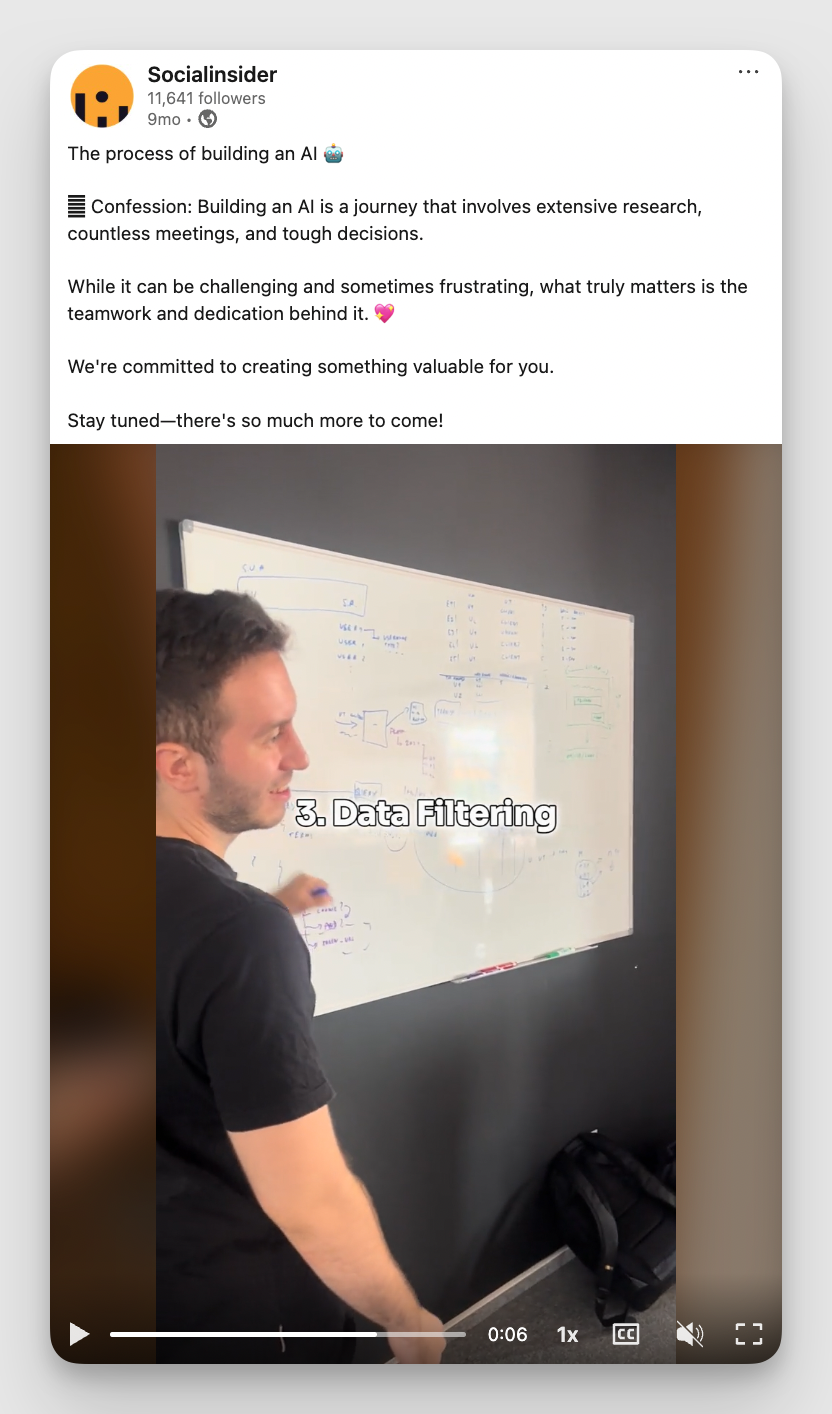
The video shows the team members doing team members' stuff. Nothing fancy, but it gives the audience a glimpse into how Socialinsider approaches product development. It teases upcoming features while showing the human side of our work.
This content performs well because people are naturally curious. They want to know how businesses operate, what goes into building products, and who's behind the company.
LinkedIn video best practices:
- Show the process, not just results. Document planning sessions or brainstorming moments that reveal how you work.
- Tease upcoming features. Use behind-the-scenes content to build excitement for product launches or announcements.
- Keep it genuine. Don't over-produce these videos. Authenticity is the whole point, and you’re very much allowed to be silly.
- Focus on people. Highlight team members to put human faces on your brand.
In our webinar, LinkedIn expert Louise Brogan highlighted three video formats that are both easy to create and highly effective for building engagement on the platform:
- Answer FAQs – Pick one client question and dedicate a short video to answering it. (Keeping it to one question per video makes your message clear and digestible.)
- Behind-the-Scenes – Show the human side of your business, whether it’s your team at work, your process, or a sneak peek at a project.
- Industry News – Share your perspective on the latest updates or trends in your field. This not only informs your audience but also positions you as a trusted thought leader.
#6. Educational and tutorial content
Educational videos work great on LinkedIn. People want to learn skills for their jobs, and tutorial content feels natural on a platform built for professional growth.
The smart thing about educational content is giving value while showing your expertise. Instead of pushing your product directly, you're teaching something useful and positioning yourself as an expert.
Socialinsider has tons of features for competitor analysis and social media analytics, and might seem confusing at first. So the team does short explanatory videos:
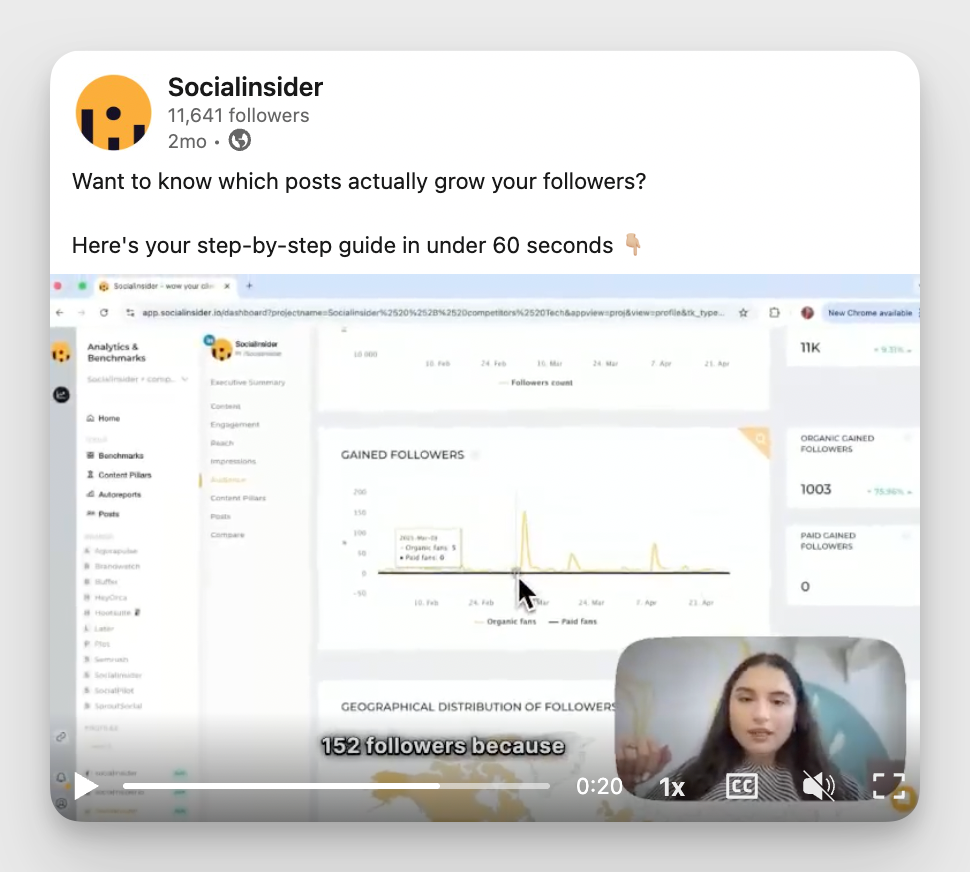
Product education, but made helpful: this post highlights the pain point, offers a solution, and also shows the tool. It’s not a direct sale but rather a social media data collection trick people can use.
And if you’re running low on ideas, hold a competitor analysis and find potential content gaps. If everyone talks about social media optimization but nobody explains how to calculate actual ROI from social campaigns, that's your spot.
LinkedIn video best practices:
- Focus on practical skills. Create tutorials viewers can use right away in their work.
- Use real examples. Show actual data, tools, or processes instead of theory.
- Keep it simple. Break complex topics into easy steps.
- Share industry insights. Educational content about your field's best practices and trends is always a fit for LinkedIn.
#7. UGC video content campaigns
Your LinkedIn video marketing strategy doesn't have to live in your account only. In the times of authenticity, UGC is the best call for B2B video content marketing.
Adding UGC to your LinkedIn posting strategy serves two goals:
- Authentic content creation: You get real content that feels genuine and builds trust with your audience
- Audience expansion: You tap into your creators' networks and reach people who might never see your brand otherwise
It’s a great way to get the essential social proof of your product and expand into unexplored audiences.
Semrush nails it rather nicely. As a part of their Semrush Partner program, they collaborate with LinkedIn creators who already use and love their platform. They encouraged creators to share helpful content like SEO and marketing tips featuring Semrush tools.
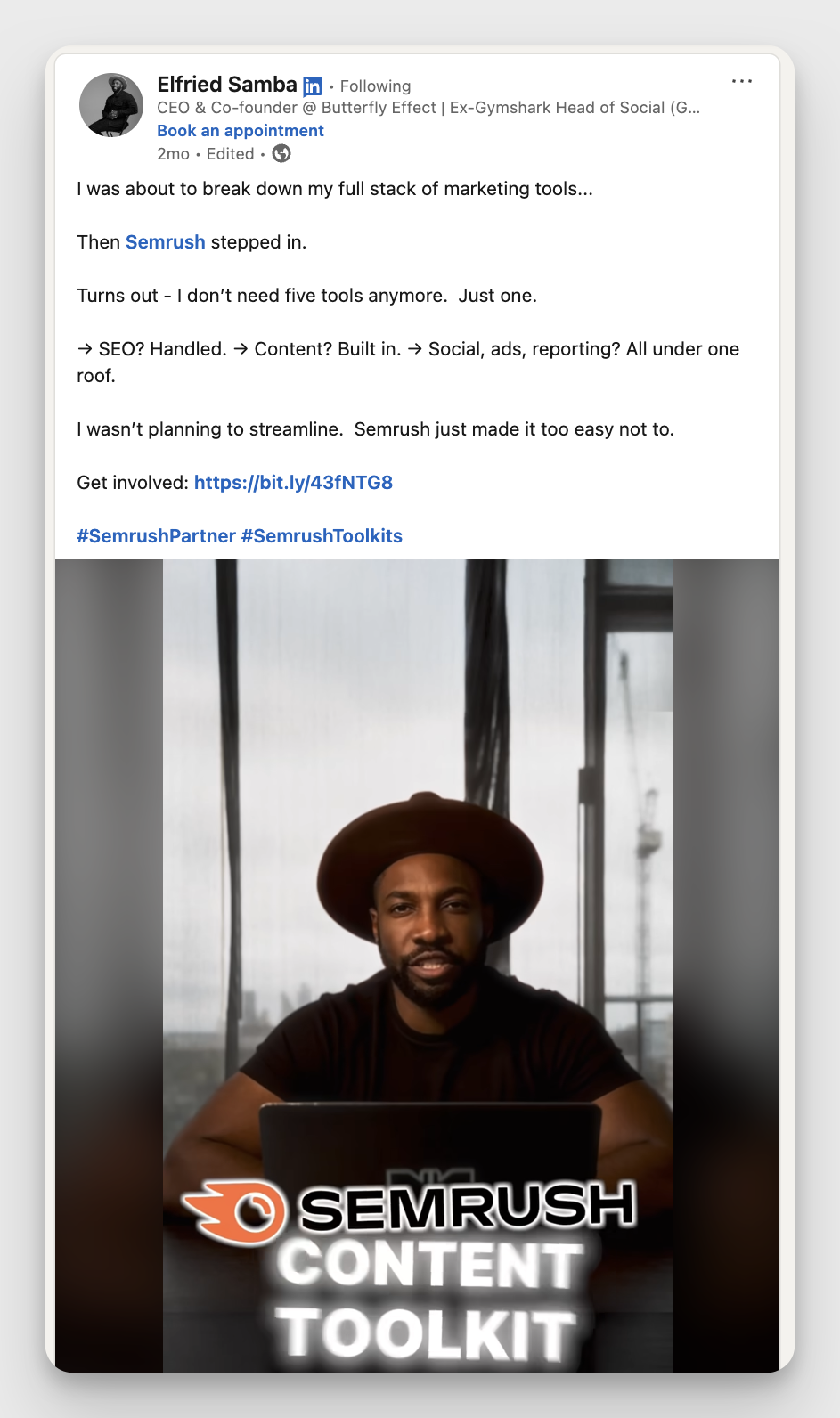
LinkedIn video best practices:
- Give clear prompts. Tell users exactly what you want: "Show us your workflow" works better than "Share your experience."
- Offer real incentives. Partner programs, discounts, or feature opportunities make participation worthwhile.
- Feature your creators. Reshare their content and give them credit to encourage more submissions (and fill in gaps in your LinkedIn posting plan).
- Engage actively. Like, comment, and respond to UGC posts, so your creators feel appreciated and their audience sees your account.
#8. Employee video posts as ad creatives
If your employees are creating content for LinkedIn and it's working organically, try including some of these videos in your paid ads creatives.
People on LinkedIn scroll right through yet another polished corporate ad. But an employee talking about their work experience or sharing insights? That feels like regular content.
Your audience doesn't immediately switch to "this is an ad" mode, which means they're more likely to watch and engage. This approach makes LinkedIn video marketing more effective by combining the organic feel and paid boost to amplify it.
LinkedIn video best practices:
- Start with the top organic performers. Use employee videos that already have high engagement as your first paid test content.
- Keep the authentic feel. Don't over-polish or add heavy branding. The natural quality is what makes them effective.
- Test different employees. Different faces and voices will resonate with different audience segments.
- Use mobile-friendly formats. Best video format for LinkedIn is vertical (9:16) or square (1:1). They fill more screen space on mobile devices than landscape.
#9. AI video
Before you grab the pitchfork and go for my soul: AI videos are controversial but also pretty helpful if you know how and where to use them.
Creating a video usually takes quite some effort and resources, and not every team can afford this. Using AI for video creation helps you add videos to your LinkedIn marketing strategy even if you don’t have a huge team or budget.
You don't have to generate videos fully with AI, but rather use it to simplify the process and scale your content creation. You can turn blog articles or sales pitches into short LinkedIn videos — like this one about Synthesia.
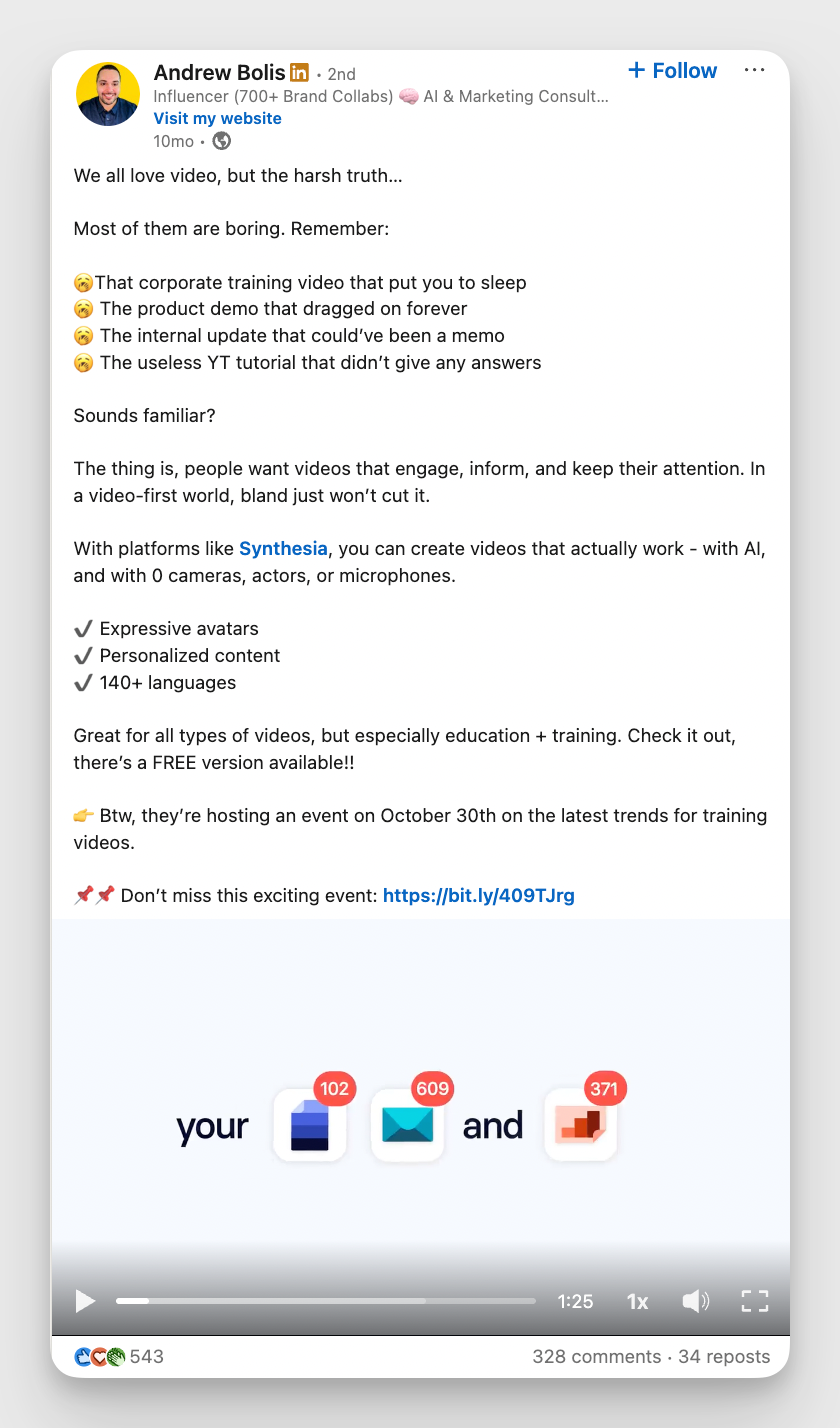
Tools like Descript and Opus Clip help you make use of existing video content and simplify editing. Platforms like Synthesia and Lumen5 help you create animated videos with voiceover or talking head content.
LinkedIn video best practices:
- Know where to use AI vs. stay authentic. Use AI for product demos and explainer videos, but keep authentic content for company culture and personal stories.
- Start with existing content. Use AI tools to turn blog posts, presentations, or longer webinar recordings into short videos on LinkedIn.
How to measure the results of your LinkedIn video marketing efforts?
It’s not enough to just post a video on LinkedIn to score in marketing. Analytics is also a vital part of your strategy. Make sure to find time to analyze your performance data to see if you’re winning.
Here are the key video metrics for you to concentrate on:
Views and engagement data
Understanding your best videos starts with looking at your views and engagement.
With Socialinsider's LinkedIn analytics, you can track engagement data and analyze the performance of individual videos in detail.
Navigate to your LinkedIn posts tab, filter content by video type, and select the specific video you want to analyze. Click on the post to access detailed metrics like views, engagement rate, and more. Identify which videos are your best performers, and double down on this type of content.
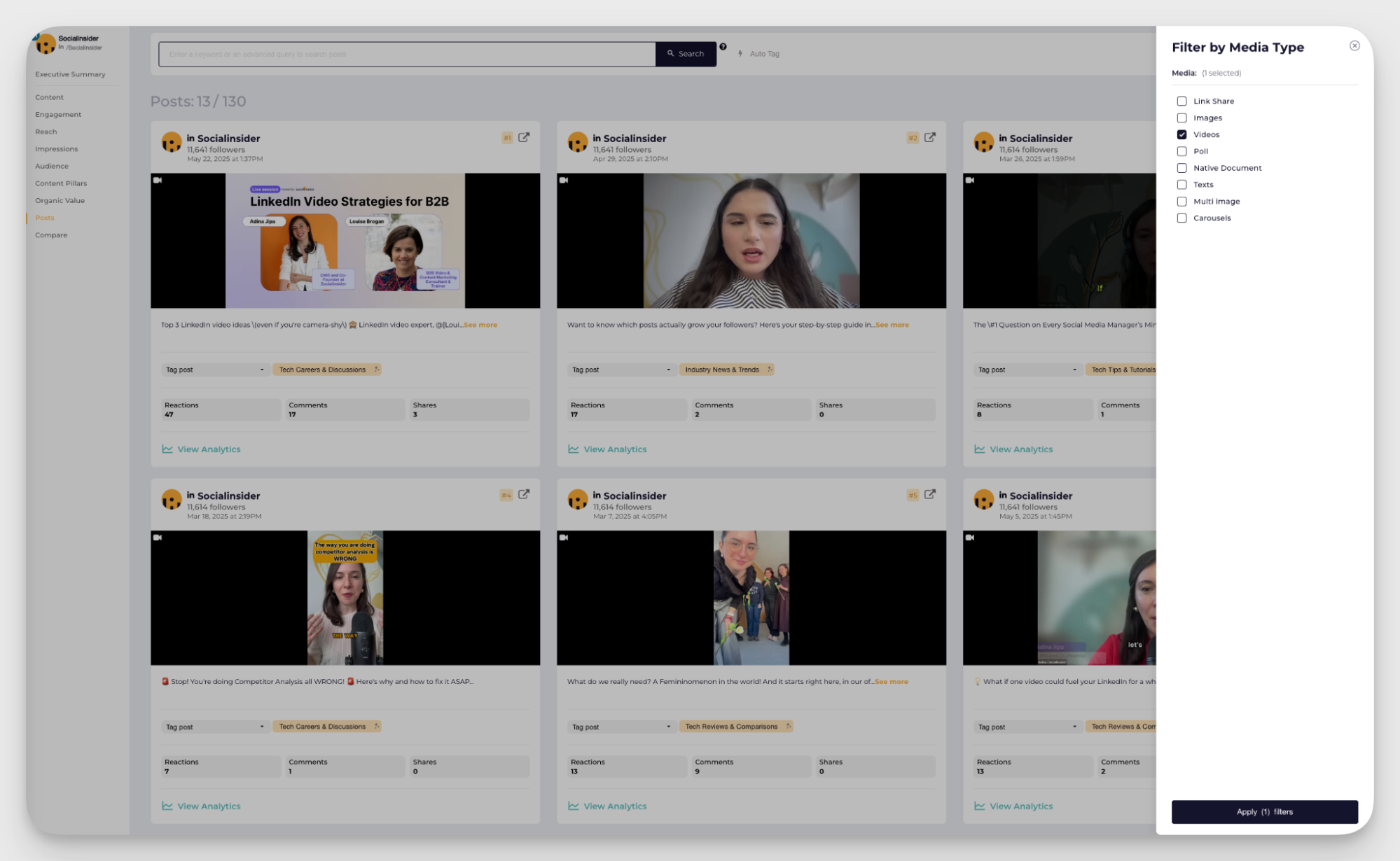
Tracking your engagement data also allows you to understand what content pillars work best. If your educational videos gain traction every time while industry news flops consistently, it’s a clear signal to your video marketing strategy.
Socialinsider offers a neat tagging system to make it easy to analyze performance by content pillar:

You can also compare your videos against competitors to see how you rank. Competitive benchmarking is extremely effective. This research gives your performance data context and allows you to understand where your content stands compared to other players in your niche.
LinkedIn’s native analytics doesn’t offer competitive insights, but special analytics tools like Socialinsider do.
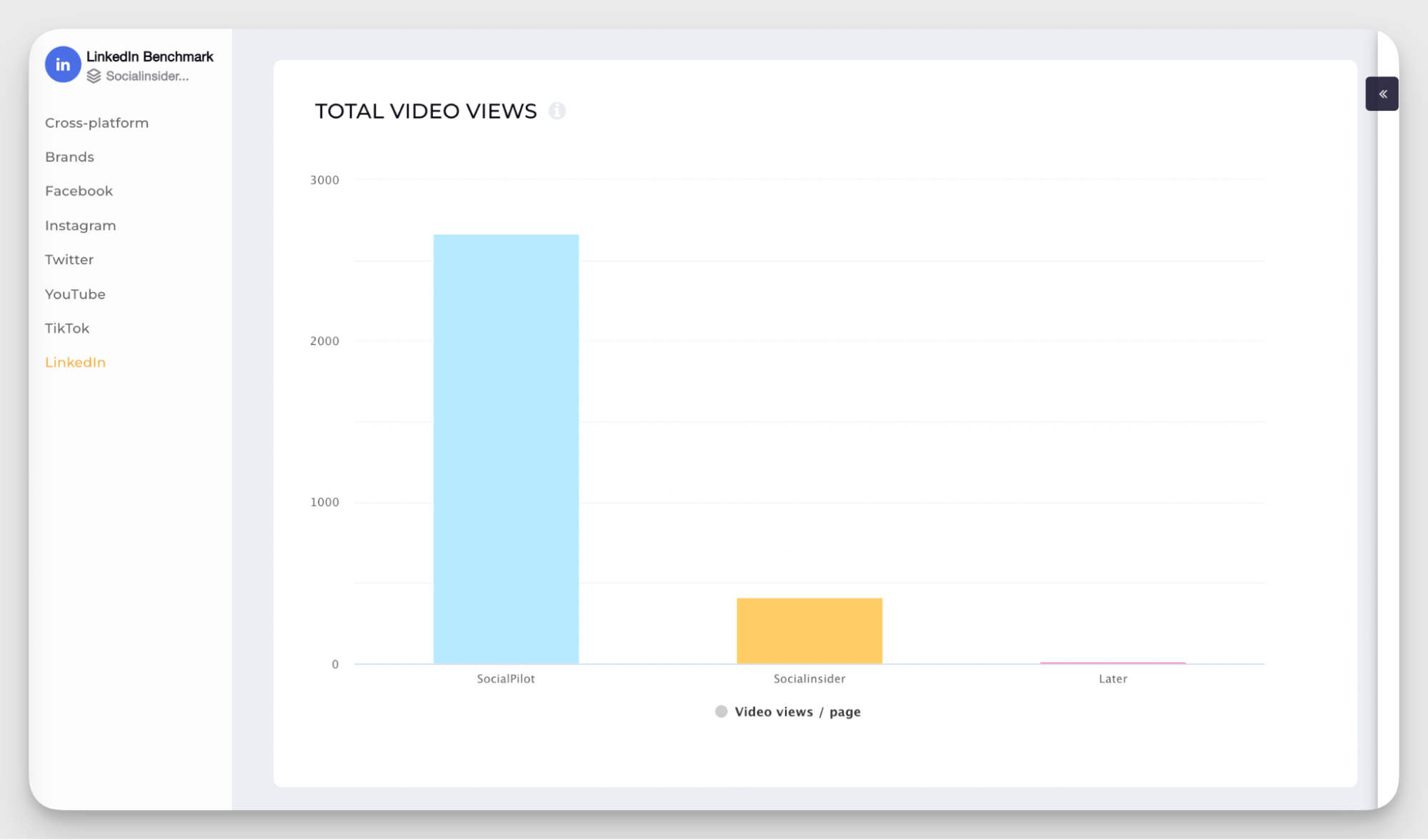
Comments and shares
Comments and shares show real audience engagement, more so than likes.
Watch for big changes in these numbers, then look at what content caused them. A jump in shares might mean you hit a trending topic. More comments suggest your content started good conversations. Use these insights to repeat what works.
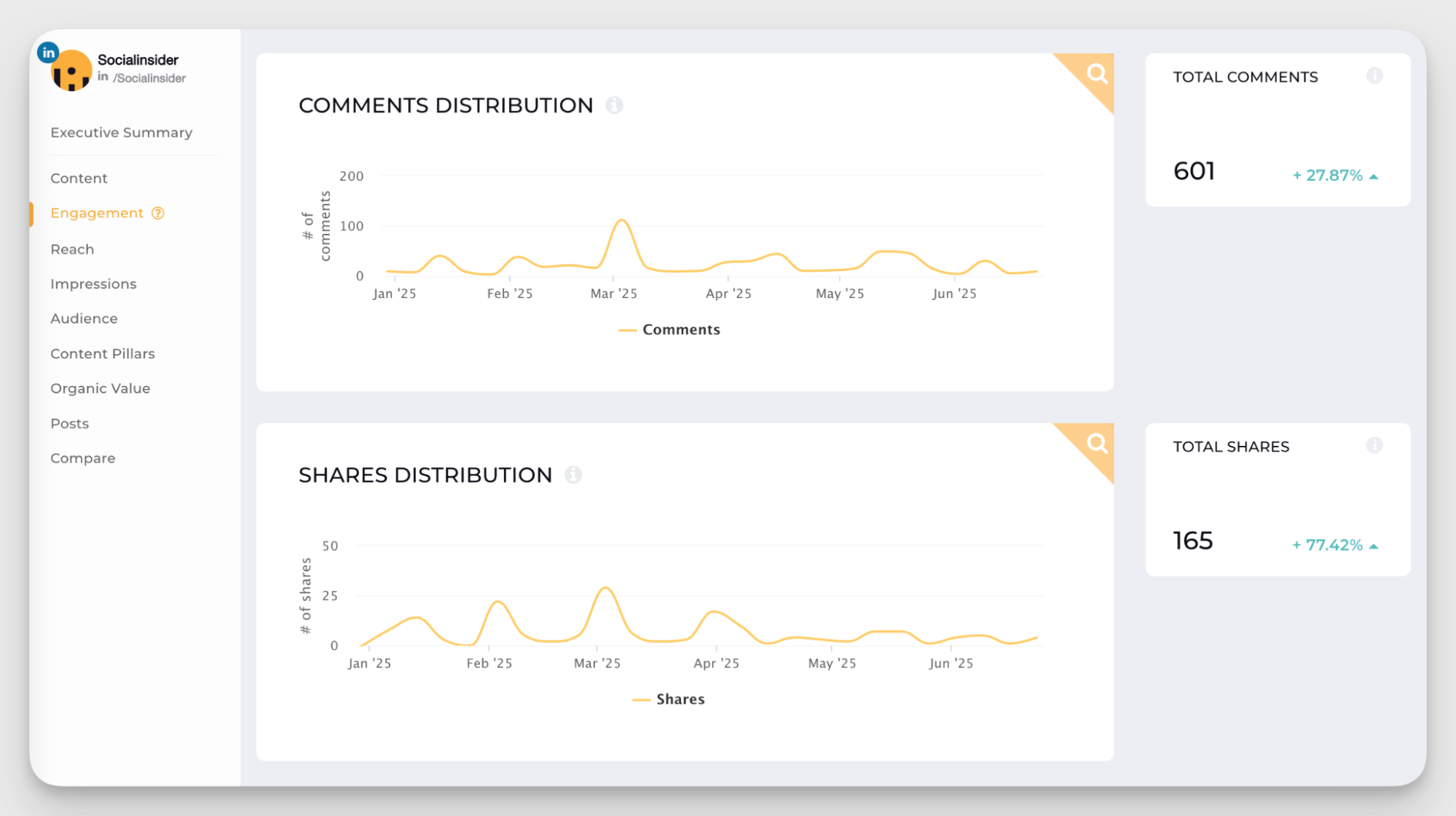
Socialinsider’s social media report shows the continuous change in your comments and shares. It makes it easy to identify the peak moments and analyze the posts behind them.
ROI
Calculating B2B social media ROI looks different for paid versus organic LinkedIn videos.
For paid campaigns, it's pretty straightforward. Track cost per view, conversion rates, and revenue from video traffic. Easy math.
Organic video ROI is trickier since there's no direct ad spend, but you can still measure business impact.
Here's how it works: You create a LinkedIn video about your upcoming webinar. From that video, 50 people sign up, 15 book demos, and 3 become customers worth $10,000 each. That's $30,000 in revenue you can trace back to one organic video post.
Track webinar signups from your videos, demo requests, and sales from those leads. This path from video to revenue shows you the real business impact of your organic content.
Customer lifelong value from video content
CLV from video content measures the long-term value of people who watch your videos.
Track this by watching traffic from video posts to your landing pages using UTM tags in links. Calculate CLV by measuring sales from video viewers and what they buy later. This shows which videos bring the most valuable customers.
CLV is a bit trickier on organic content, especially since all LinkedIn posting tips encourage you to drop the links for a bigger reach. However, it still stands for paid campaigns and rare cases of links in the post body.
Successful LinkedIn video marketing example
tl;dv really cracked the code for a smart LinkedIn video marketing strategy. They went ahead and turned their workers into content creators instead of corporate speakers.
The company uses three team members: Renee Shaw, Ian Evans, and Tomas Budin. They make unique and painfully real videos about workplace problems, from meeting fatigue to beef between sales and everybody else.
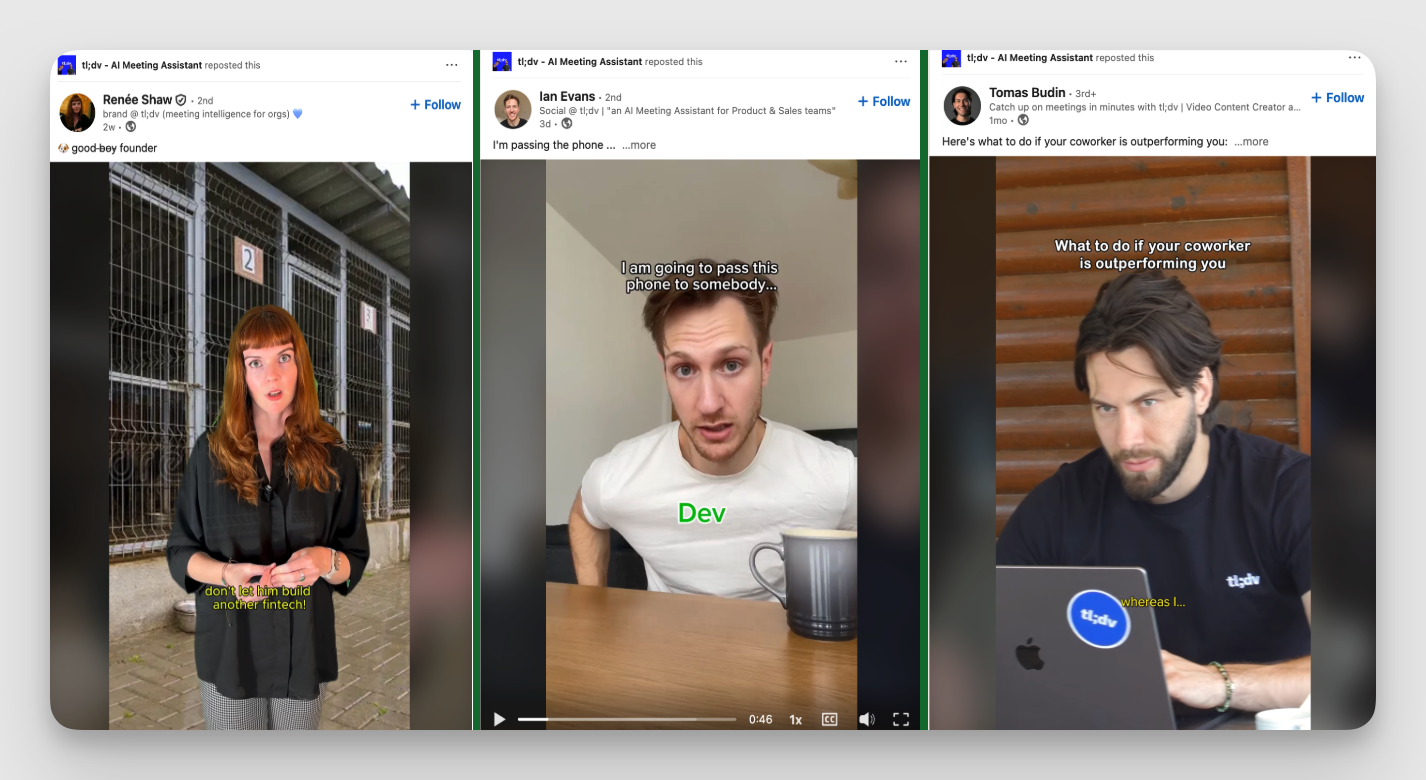
This works because it feels natural, sometimes borderline corny. But that’s what makes it stick so much.
It’s not an ordinary ad, and it’s also not a brand that is trying too hard to fit in with the cool kids. It’s the cool kids who shoot fun videos that sometimes are not even about the product itself, but still work on bringing more eyes to it. Each creator built their own following while staying true to tl;dv's main message about better communication.
Engagement data tells a convincing story. The videos get tons of likes, comments, and shares because they’re very relatable. Very.
This approach helped tl;dv build real relationships with their audience and gave them very solid organic reach.
Final thoughts
LinkedIn video marketing is now key for business growth — that much we can establish. The shift to LinkedIn video is happening, and brands that adapt to it now set up for the win.
Every business has a place for video content in its B2B social media marketing strategy. There’s always something valuable you can show: from everyday work to feature showcase and webinar highlights.
And the best thing is: you don't need big budgets or flashy production. Just be real and helpful.
Not sure if you’re heading in the right direction? Analytics will show what works and what doesn't. Socialinsider helps you track core performance metrics and perform competitor analysis. Skip the guesswork — use the data instead.
Kseniia Volodina
Content marketer with a background in journalism; digital nomad, and tech geek. In love with blogs, storytelling, strategies, and old-school Instagram. If it can be written, I probably wrote it.
Analyze your competitors in seconds
Track & analyze your competitors and get top social media metrics and more!
You might also like
Improve your social media strategy with Socialinsider!
Use in-depth data to measure your social accounts’ performance, analyze competitors, and gain insights to improve your strategy.


